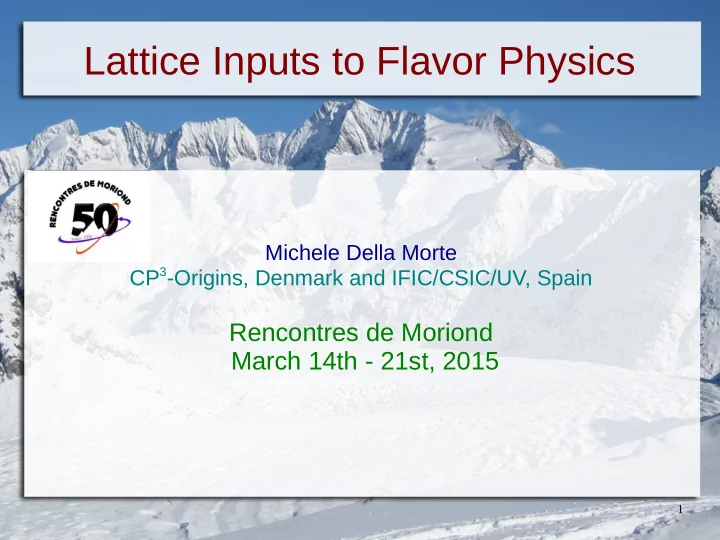

Lattice Inputs to Flavor Physics Michele Della Morte CP 3 -Origins, Denmark and IFIC/CSIC/UV, Spain Rencontres de Moriond March 14th - 21st, 2015 1
2
Several hadronic processes depend on hadronic contributions. E.g. 3
4
5
Lattice can provide first principle – systematically improvable determinations of such parameters. However they are not free from approximations / systematics ➢ Number of dynamical flavours ➢ Unphysical quark masses (and no isospin breaking) ➢ Finite lattice spacing ➢ Finite volume ➢ Renormalization FLAG's goal is to walk users of lattice results through systematics and the way they have been addressed 6
7
Criteria, as of now 8
For heavy-light quantities, in order to deal with the different approaches, we used data-driven criteria. We introduced for a = a min and then used Only results with no red symbols enter the final estimates 9
Light quark masses ' Estimates ' differ from ' averages '. For N f =2+1 an error coming from ● quenching of the charm has been included 10
Leptonic and semileptonic Kaon and pion decays 11
|V u | 2 =0.987(10). The consistency with leptonic and semi-leptonic determinations of |V us | is a check of the equality of the Fermi constant describing interactions among leptons and the one describing interactions among leptons and quarks (may not be in BSM). 12
The hadronic parameter in ε K at LO in the EWH 13
14
15
B-> π l ν form factors ● Few lattice results, in the region complementary to experiments ● CKM matrix element fitted to normalize exp data 16
B->D (*) l ν and R(D (*) ) PS -> V form factors are usually computed at zero recoil. In that limit ● only one form factor is relevant (others are helicity suppressed). 17
18
Natural idea would be ● new contributions from charged scalar exchanges. However, those would ● enhance the leptonic channel as well. It is difficult to ● accommodate the discrepancy in 2HDM without FCNC at tree level [Celis, Crivellin]. Otherwise, some leptoquark models can explain it [Tanaka, Watanabe, 2013]. In general, in BSM theories other form factors (S, PS, T) may appear [Nierste, Trine, Westhoff '08, Kamenik, Mescia '08, Kamenik, Fajfer, Nisandzic '12, Biancofiore …]. Clear opportunities for lattice 19
QED effects are becoming relevant for light quantities. QCD + QED direct simulations [Borsanyi et al., BMW group, 2014] ● Large volume 1+1+1+1 simulations of QCD + QED (at unphysical e due to noise to signal problem). 300 times more expensive than N f =2 QCD. Pilot and benchmark computation concerning the setup. ● Separation of effects using ΔM QED =0 20 Σ
ǁ Number external photons 21
22
23
2 ensembles of 2+1 DW fermions with L~5 fm and physical m π . NP renormalization in RI-SMOM scheme. Matching to MS at 1- loop. Currently dominating error budget. 24
25
Conclusions ● I have given an incomplete review of flavor physics on the lattice. ● I did not cover tensions as those still present in V ub and V cb (excl. vs incl.). ● If the keywords are precise and rare, we are getting there. Approaches to include sub-leading systematics being developed (QED, multi-hadron channels). ● Belle II, LHCb (run II) and BES-III put pressure on us. 26
Recommend
More recommend